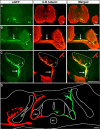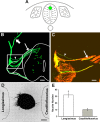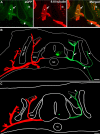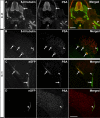Motoneurons derived from embryonic stem cells express transcription factors and develop phenotypes characteristic of medial motor column neurons
- PMID: 16554476
- PMCID: PMC6674087
- DOI: 10.1523/JNEUROSCI.5537-05.2006
Motoneurons derived from embryonic stem cells express transcription factors and develop phenotypes characteristic of medial motor column neurons
Abstract
Embryonic stem (ES) cells differentiate into functional motoneurons when treated with a sonic hedgehog (Shh) agonist and retinoic acid (RA). Whether ES cells can be directed to differentiate into specific subtypes of motoneurons is unknown. We treated embryoid bodies generated from HBG3 ES cells with a Shh agonist and RA for 5 d in culture to induce motoneuron differentiation. Enhanced green fluorescent protein (eGFP) expression was used to identify putative motoneurons, because eGFP is expressed under the control of the Hb9 promoter in HBG3 cells. We found that 96 +/- 0.7% of the differentiated eGFP+ motoneurons expressed Lhx3, a homeobox gene expressed by postmitotic motoneurons in the medial motor column (MMCm), when the treated cells were plated on a neurite-promoting substrate for 5 d. When the treated embryoid bodies were transplanted into stage 17 chick neural tubes, the eGFP+ motoneurons migrated to the MMCm, expressed Lhx3, projected axons to the appropriate target for MMCm motoneurons (i.e., epaxial muscles), and contained synaptic vesicles within intramuscular axonal branches. In ovo and in vitro studies indicated that chemotropic factors emanating from the epaxial muscle and/or surrounding mesenchyme likely guide Lhx3+ motoneurons to their correct target. Finally, whole-cell patch-clamp recordings of transplanted ES cell-derived motoneurons demonstrated that they received synaptic input, elicited repetitive trains of action potentials, and developed passive membrane properties that were similar to host MMCm motoneurons. These results indicate that ES cells can be directed to form subtypes of neurons with specific phenotypic properties.
Figures









Similar articles
-
Functional properties of motoneurons derived from mouse embryonic stem cells.J Neurosci. 2004 Sep 8;24(36):7848-58. doi: 10.1523/JNEUROSCI.1972-04.2004. J Neurosci. 2004. PMID: 15356197 Free PMC article.
-
Easy and rapid differentiation of embryonic stem cells into functional motoneurons using sonic hedgehog-producing cells.Stem Cells. 2007 Jul;25(7):1697-706. doi: 10.1634/stemcells.2006-0654. Epub 2007 Mar 29. Stem Cells. 2007. PMID: 17395777
-
Directed differentiation of embryonic stem cells into motor neurons.Cell. 2002 Aug 9;110(3):385-97. doi: 10.1016/s0092-8674(02)00835-8. Cell. 2002. PMID: 12176325
-
Transcriptional codes and the control of neuronal identity.Annu Rev Neurosci. 2002;25:251-81. doi: 10.1146/annurev.neuro.25.112701.142916. Epub 2002 Mar 27. Annu Rev Neurosci. 2002. PMID: 12052910 Review.
-
The acquisition of motoneuron subtype identity and motor circuit formation.Int J Dev Neurosci. 2001 Apr;19(2):175-82. doi: 10.1016/s0736-5748(00)00090-3. Int J Dev Neurosci. 2001. PMID: 11255031 Review.
Cited by
-
Improved method for ex ovo-cultivation of developing chicken embryos for human stem cell xenografts.Stem Cells Int. 2013;2013:960958. doi: 10.1155/2013/960958. Epub 2013 Mar 11. Stem Cells Int. 2013. PMID: 23554818 Free PMC article.
-
Controlling destiny through chemistry: small-molecule regulators of cell fate.ACS Chem Biol. 2010 Jan 15;5(1):15-34. doi: 10.1021/cb900249y. ACS Chem Biol. 2010. PMID: 20000447 Free PMC article. Review.
-
Cytochrome p450 cyp26a1 alters spinal motor neuron subtype identity in differentiating embryonic stem cells.J Biol Chem. 2013 Oct 4;288(40):28801-13. doi: 10.1074/jbc.M113.474254. Epub 2013 Aug 13. J Biol Chem. 2013. PMID: 23946489 Free PMC article.
-
Foxp1-mediated programming of limb-innervating motor neurons from mouse and human embryonic stem cells.Nat Commun. 2015 Apr 14;6:6778. doi: 10.1038/ncomms7778. Nat Commun. 2015. PMID: 25868900 Free PMC article.
-
A stem-cell based bioassay to critically assess the pathology of dysfunctional neuromuscular junctions.PLoS One. 2014 Mar 13;9(3):e91643. doi: 10.1371/journal.pone.0091643. eCollection 2014. PLoS One. 2014. PMID: 24626225 Free PMC article.
References
-
- Abercrombie M (1946). Estimation of nuclear population from microtome sections. Anat Neurobiol Rec 94:239–247. - PubMed
-
- Bjorklund LM, Isacson O (2002). Regulation of dopamine cell type and transmitter function in fetal and stem cell transplantation for Parkinson's disease. Prog Brain Res 138:411–420. - PubMed
-
- Chisholm A, Tessier-Lavigne M (1999). Conservation and divergence of axon guidance mechanisms. Curr Opin Neurobiol 9:603–615. - PubMed
-
- Dasen JS, Tice BC, Brenner-Morton S, Jessell TM (2005). A hox regulatory network establishes motor neuron pool identity and target-muscle connectivity. Cell 123:477–491. - PubMed
Publication types
MeSH terms
Substances
LinkOut - more resources
Full Text Sources
Other Literature Sources
Research Materials
